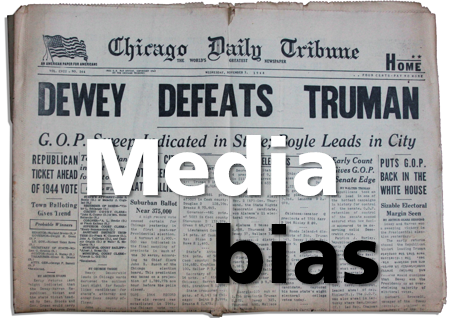
Something wonderful has been happening on our social media since Trump’s triumph. It is, unfortunately, a response to a national realization about the election: during the campaign, there were a lot of people passing around “news” that turned out to be seriously misleading at best or outright lies and disinformation in many cases. Now that the truth about the lies about the truth has started to filter out, people all over America are suddenly taking a very skeptical view of internet news sources that they relied on heavily during the election. They are on the hunt for unbiased news.
I think it’s great that people are looking into how to find unbiased news sources. But there’s a few things they need to keep in mind:
- No news source is going to be completely unbiased (despite whatever claims it or others make about it). They are made of people doing a stressful and often unforgiving job. Some have definite agendas. Others have a specific set of experiences on which they base a picture of how the world works. Others may actually run against their bias by over-correcting. And almost all work in an environment as driven by the all-powerful dollar as any of the rest of us. Each news source is an amalgamation of people of varying kinds; the best you can hope for is a mix that balances itself out.
- There is no clear definition or measure for bias in news because bias can operate in so many ways. Balance isn’t just about giving the same airtime to both sides of an argument. It’s also speaking truth to those powerful sides and correcting the record. It’s about what gets covered, how much space it gets, how effective the writing is, when it gets run, how much promotion it gets. It’s about vocabulary and style and tone and depth. Many of those can only be measured with some taint of subjectivity. It’s how both sides can point to Politifact.com or Snopes.com and claim that the fact-checking websites are biased against them, and be absolutely honest in their feelings. And, taken together, all of this makes it virtually impossible to scientifically determine a level or absence of bias.
- That means that you need to be as skeptical of your sources on who’s-biased-and-who-isn’t as you now are about news sources. You need to make sure those sources are reliable before leaning on them. For example, one of the media bias site being widely lauded and shared on social media right now states that it uses how many times certain words or terms are used to determine bias. For example, the term “partial-birth abortion.” That’s a politically biased term. The unbiased term is “D&X.” But an article can use the term “partial-birth abortion” in describing how those against it talk about it. That makes the news source less biased because it is reporting how those people identify. Meanwhile, the fact that the law banning the procedure is called the “Partial Birth Abortion Ban Act of 2003” means that any news source that mentioned the Act would look more biased to the right than one which didn’t—even though to talk about the fact that the procedure has been banned for 13 years but we still have politicians railing against the procedure (Trump) actually tilts one more to the left. A computer cannot make those kinds of calculations. And a person cannot make them without a taint of subjectivity. Either way is problematic.
- That doesn’t mean that you shouldn’t try to sort the wheat from the chaff. You absolutely should. But it does mean that relying on someone else’s list is just the beginning. You’re still going to have to dig a bit deeper to find the truth.
So how do you get beyond the biased-or-not lists?
Obviously, if something only shows up on alt-right and alt-left sources, it’s likely not true. That’s easy enough. But sometimes, even a biased source can reveal the truth. When you read a news report on a source you know is biased, look for links in the article. Many times, the links embedded in the article will take you to more mainstream sources that show the same or similar information reported elsewhere. That’s more likely to indicate it’s true. Not the links themselves―because I have literally found alt-right articles that link to mainstream articles that say precisely the opposite of what the alt-right article claims. They are hoping you won’t click through to check out the link. But you need to. Because if nothing else, you’ll find an article from a less biased source and you can share that, rather than something from an alt site.
And remember, nothing beats a Google search. If you doubt what you are reading, grab some keywords from the suspect article and take 20 seconds to do a Google search. If it returns something by Politifact or Snopes, you can follow them and learn a lot more about the truth. If you see the article or news announcement repeated only by alt sites or sites with foreign addresses or poor English, that’s a good indication it’s BS. And obviously, if lots of mainstream news sources are reporting the same thing, it’s more likely to be true. Not a lock. Just a lot more likely.
And it’s most important that you don’t stop with the idea of biased and unbiased. Try to also think of “informed” vs. “uninformed.” One of the media bias sites out there says USA Today is not biased but BBC news is slightly biased to the left (hardly surprising since England as a nation is a bit further to the left than we are).
But USA Today provides you tiny snippets of information―it’s the Twitter of the news world. BBC News will often spend 20 or 30x the amount of time on a news story, giving you greater depth and context. That makes you more informed on that subject. USA Today only gives you the illusion of being informed.
And this movement is all about getting past that illusion.
So let me be clear: I think it’s great that people are trying to recognize and shun media bias. That’s a very hopeful sign for our country. Just make sure that you are doing it smartly and not just accepting someone else’s idea of who’s biased and who isn’t. That’s how we got into this mess in the first place.
Oh, and just in the interests of full disclosure, I am on the left. Natch.
